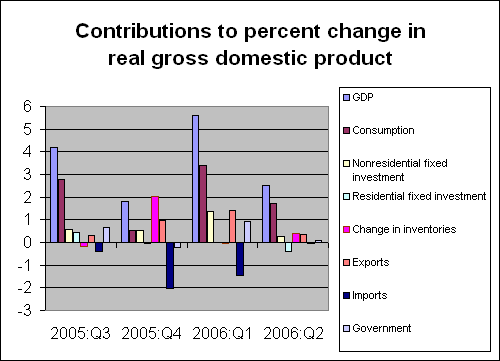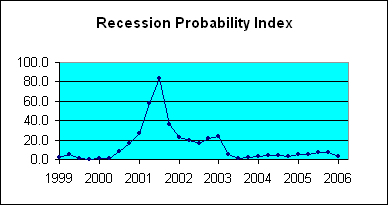As expected, GDP growth slowed significantly in the second quarter.
The Commerce Department announced today that U.S. real GDP grew at an annual rate of 2.5% in the second quarter of 2006, less than half the whopping 5.6% growth now reckoned to have characterized 2006:Q1. To a first pass, it might appear as if growth rates for all the components of GDP have simply been downsized.

In some areas, such as imports and government spending, such downsizing might be welcome. Import growth drained 1.5% from 2006:Q1 GDP growth, but imports barely increased at all in 2006:Q2, so that for the first time in a year, net exports made a positive contribution to GDP growth. Less spending by U.S. residents overall usually means less spending on imports as well. If U.S. growth slows while that of our trading partners does not, that may be much more effective than a depreciation of the exchange rate in bringing the trade balance to a more manageable level.
In other areas, downsizing is distinctly unwelcome. Exports and nonresidential fixed investment are the two areas I would like to see playing a lead role in economic growth. Between them they contributed 2.8% to 2006:Q1 growth, but just a little over half a percent for 2006:Q2. Fed Chair Ben Bernanke has expressed hope that
investment in nonresidential structures, which had been weak since 2001, seems to have picked up appreciably, providing some offset to the slower growth in residential construction.
But with nonresidential investment contributing +0.28% to 2006:Q2 and residential investment -0.4%, it seems safe to say that Bernanke’s optimism does not find much confirmation in the 2006:Q2 advance estimates.

Nevertheless, the 2006:Q1 growth was so strong that it brought the recession probability index down from 7.1% for 2005:Q4 to 3.4% for 2006:Q1, a very favorable reading. This index is not a forecast of where the economy will be later this year, but is a backward-looking assessment of where the economy was as of 2006:Q1, using the latest data to form that assessment. It is intended as an alternative to the announcements made by the National Bureau of Economic Research, which, although highly authoritative and reliable, often fail to be made public until years after a recession has started. Background on how the recession probability index is constructed and a review of its historical performance are available here.
Technorati Tags: GDP,
recession probability,
recession probability index
Growth is down and inflation indicators up. Sounds like (oil) trouble to me.
We all should be hoping for stronger growth for the export and investment sectors – which is the sad underbelly of this report of weak GDP growth. Oh well – there is the third quarter to look forward to.
I have to say, this “recession probability index” seems pretty superfluous these days. It’s not exactly headline news that we were not in a recession six months ago. And it’s prety hard to wrap my head around the concept that maybe there is a 3.4% probability that we actually were in a recession in Q1 but somehow didn’t notice it.
But I’m sure there will come a time when this index does not seem nearly so comical, and in fact we will look to it with considerable interest and respect as we puzzle over whether the long-awaited recession is really here at last.
Quite right, Hal. One of my goals is simply to be on record announcing the index in real time. The fact that the index has so far been saying something that everybody already knew is in my opinion a point to recommend its credibility, if not its current news value. As you say, the time may come soon when having an objective number to add the the public discussion may be welcome.
So today the stock market rallied because of slowing growth, apparently giving hope that the Fed will stop raising interest rates. So why the big push to make the Bush tax cuts permanent so that we can increase the rate of growth again? It seems that the more you lower taxes the higher the Fed will push interest rates to retard growth. So what is the point? I can see the reason for a temporary stimulus tax cut in 2001, but what is the justification for making the cuts permanent, especially considering that they are financed by deficits?
I’m with you on this one, Joseph. I do not think it makes sense from the point of view of stimulating aggregate demand to couple an expansionary fiscal policy with a contractionary monetary policy. Moreover, I see no good reason to want to stimulate aggregate demand in the current situation.
If there is a coherent economic motivation for the tax cuts, it must come from the supply side, although you are correct that many of the arguments we hear about stimulating spending are basically demand-side arguments.
How do you distinguish between tax cuts that stimulate supply vs. demand? Is it tax cuts for capital gains and dividends vs. wages? Or for the wealthy vs. poor?
You said that a supply side argument would be required at this time. Is there an assumption that supply side stimulation does not cause inflation so is okay in the current environment? It would seem that a supply stimulus would drive up wages while a demand stimulus could drive up prices, but both would eventually lead to inflation.
And if capital gain cuts work on the supply side, why would we need them in 2003 when interest rates were at record lows, implying no shortage of capital?
Joseph, a particular proposed change in taxes would likely have consequences for both supply and demand. The issue is which effect a particular advocate expects to be the most important.
From my perspective, the key feature that would define a supply-side analysis is an emphasis of the effect of the tax change on a relative price, such as trying to increase the after-tax return to labor (by reducing taxes on wages) or increasing the after-tax return to saving (for example, by reducing taxes on capital gains). With either one of these, you could find some economists who believe the incentive effects would be big and those who think they would be small.
I put myself in the camp of those who are skeptical of the claims for big effects.
Hal, on reading Dave Altig’s latest post, I’m reminded of another benefit of reporting the index regularly– it’s an objective summary statistic that can sometimes temper our subjective reactions to the news. In this case, it calls our attention to the fact that the really robust 2006:Q1 growth should be balanced in with the disappointing 2006:Q2 results. And of course, it’s the disappointing 2006:Q2 and 2005:Q4 results that account for why the index is as high as 3.4%, despite the spectacular first-quarter growth.